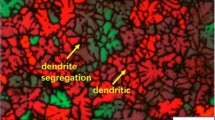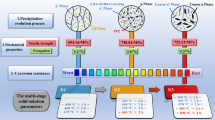Abstract
The effects of alloy composition (Zn/Mg ratio and Ti content) on the microstructure and properties of Al–3.5Mg–xZn–1.22Cu–0.2Zr–yTi aluminum alloy were studied in this paper. The results show that after solution treatment at 450°C × 2h + 460°C × 2h + 470°C × 2h + 475°C × 2h, when the Zn/Mg ratio of the alloy increases from 3.55 to 3.85, the grain size of the alloy increases, the insoluble phase increases, the dislocation decreases, and the intergranular corrosion resistance decreases gradually. Under the condition of T6 aging, the hardness and electrical conductivity of the alloy decreased at first and then increased, and the compressive strength at room temperature also decreased at first and then increased, and the hardness and compressive strength reached the maximum when the Zn/Mg ratio was 3.85. When Zn/Mg is constant, with the increase of Ti content (0–0.88 wt %), the recrystallization degree of the alloy decreases, the insoluble phase increases, the dislocation density and strengthening value gradually decrease, the inter-granular corrosion resistance decreases gradually, and the hardness, electrical conductivity and compressive strength of the alloy decrease gradually under T6 aging.









Similar content being viewed by others
REFERENCES
Cao Jingzhu and Wang Zhutang, Light Alloy Process. Technol., 2013, vol. 41, p. 1.
Xiong Baiqing, Report on the Development of China’s New Materials Industry, 2009, China Society for Materials Research, 2010, vols. 43–51.
Dursun, T. and Soutis, C., Mater. Des., 2014, vol. 56, p. 862.
Ji Hao, Aviation Sci. Technol., 2015, vol. 26, p. 75.
Jiang Dafa, Zhou Li, Chen Jingjing, et al., Electric Locomotive and Urban Rail Vehicle, 2019, vol. 42, p. 31-car.
Wang, Y., Xiong, B.Q., Li, Z.H., et al., Rare Met., 2019, vol. 38, no. 4, p. 343.
Naeem Haider, T., Mohammed Kahtan, S., Ahmad Khairel, R., et al., Adv. Mater. Sci. Eng., 2014, vol. 2014, p. 686474.
Fang, H.C., Chen, K.H., Chen, X., et al., Mater. Sci. Eng., A, 2011, vol. 528, p. 7606.
Wang, X.D., Nie, Z.R., Lin, S.P., et al., Mater. Sci. Forum, 2009, vols. 610–613, p. 663.
Li, P.Z., Li, Z., and Long, Z., Adv. Mater. Res., 2014, vol. 2954, p. 316.
Jiang, F.L., Zhang, H., Ji, X.K., et al., Mater. Sci. Eng., A, 2014, vol. 595, p. 10.
Zuo, X.R. and Ni, P.X., Adv. Sci. Lett., 2011, vol. 4, no. 3, p. 1182.
Wang, J.H., Yi, D.Q., Wang B, et al., Trans. Nonferrous Met. Soc. China, 2003, vol. 13, no. 3, p. 590.
Pourkia, N., Emamy, M., Farhangi, H., et al., Mater. Sci. Eng., A, 2010, vol. 527, no. 20, p. 5318.
Youssef, K.M., Scattergood, R.O., Murty, K.L., et al., Scr. Mater., 2006, vol. 54, no. 2, p. 251.
Zhao, Y.H., Liao, X.Z., Jin, Z., et al., Acta Mater., 2004, vol. 52, no. 15, p. 4589.
Luo, P., Mcdonald, D.T., Xu, W., et al., Scr. Mater., 2012, vol. 66, no. 10, p. 785.
Cabibbo, M., Mater. Sci. Eng., A, 2013, vol. 560, p. 413.
Luo Shoujing, Chen Bingguang, Qi Pixiang, et al., Liquid Die Forging and Squeeze Casting Technology, Beijing: Chemical Industry Press, 2007.
Funding
The authors would like to acknowledge the financial support of Industrial Science and technology support program of Jiangsu province (grant no. BE2008118), and the Key Projects of the 13th Five-Year Plan Equipment Pre-research Foundation of the Ministry of Equipment Development of the Central Military Commission of China (no. 6140922010201).
Author information
Authors and Affiliations
Corresponding author
Ethics declarations
The authors of this work declare that they have no conflicts of interest.
Additional information
Publisher’s Note.
Pleiades Publishing remains neutral with regard to jurisdictional claims in published maps and institutional affiliations.
Rights and permissions
About this article
Cite this article
Ye, J., Yin, S. & Xu, X. Effects of Different Zn/Mg Ratio and Ti Content on Hot Extruded 7xxx series Aluminum Alloy. Prot Met Phys Chem Surf 59, 1239–1249 (2023). https://doi.org/10.1134/S2070205123701216
Received:
Revised:
Accepted:
Published:
Issue Date:
DOI: https://doi.org/10.1134/S2070205123701216




